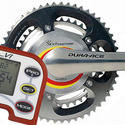Wing shapes and sizes of both birds and planes determine how they might perform or what they might be capable of (for example, gliding, sustained high speed and manoeuvrability). One way in which the shape of the wing can be described is through wing aspect ratio.
Wing aspect ratio
The ratio of the length of wings to their width is called aspect ratio. A high aspect ratio indicates long, narrow wings. A low aspect ratio indicates short, wide wings.
Aspect ratio = wing length (m)/wing width (m)
Generally, high aspect ratio wings give slightly more lift and enable sustained, endurance flight, while low aspect ratio wings are best for swift manoeuvrability.
High aspect ratio wings
Stability: Long narrow wings give a plane or bird more stability. (It’s a bit like a tightrope walker who holds a long pole across their body as they walk along the rope – the extra ‘arm’ lengths help to balance the body by adding more mass to either side of it.) The trade-off is that this type of plane won’t be very manoeuvrable.
Less induced drag Long, narrow wings also have less induced drag than shorter wider wings. Induced drag is created at the tips of the wings where the high pressure air from beneath the wing comes up over the wing tips into the low pressure zone. This meeting place of different air pressures becomes a turbulent area creating induced drag. Long narrow wings have less end edges (tips) and more stable wing area than shorter wider wings so they have less drag.
Less fuel consumption: Having less induced drag means there is less fuel consumption for planes and birds (fat consumption) so they can keep their speed for a longer time than short wide-winged fliers.
Low aspect ratio wings
Higher fuel consumption: Shorter wider-winged planes and birds have a bigger wing tip edge, which means more induced drag. This means they go slower unless they have extra power to counteract the drag. More fuel would be needed to keep them at a constant speed.
More manoeuvrable: The less stable wing area means the low aspect ratio wing is more manoeuvrable than the high aspect ratio wing. The peregrine falcon, for example, tucks its wings in (producing a low aspect ratio) for swift manoeuvrability.
Aspects ratios and wing loading are combined for different flying capabilities. For example, high aspect ratio combined with low wing loading is used for slow flight such as gliding or soaring.
Activity ideas
Continue the learning with your students with one or more of these activities
- Birds and planes – explore the importance of wing shape and size and how this determines the flight capabilities of birds and planes.
- Aerofoils and paper planes – learn how to make an aerofoil and to make and fly paper planes.
- Making a glider – handcraft a glider from balsa wood and in the process learn about aerofoil wing shape, glider parts and terminology. Then experiment with flight using variables of wind and nose weight.
- Observing wings for flight has suggestions on how to use the interactive Wings for flight graphic organiser. Wings for flight is useful as a pre-test or post-test for summative assessment.





















